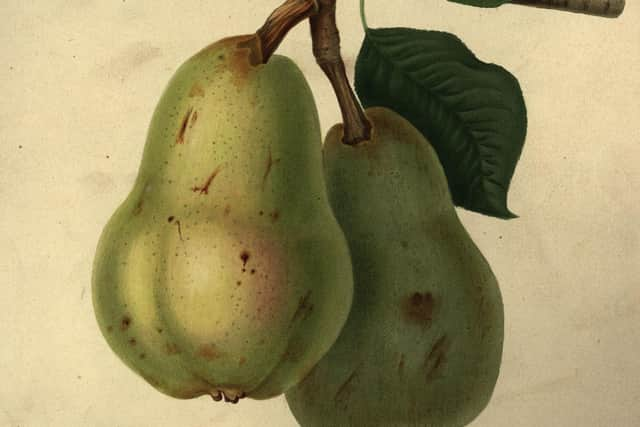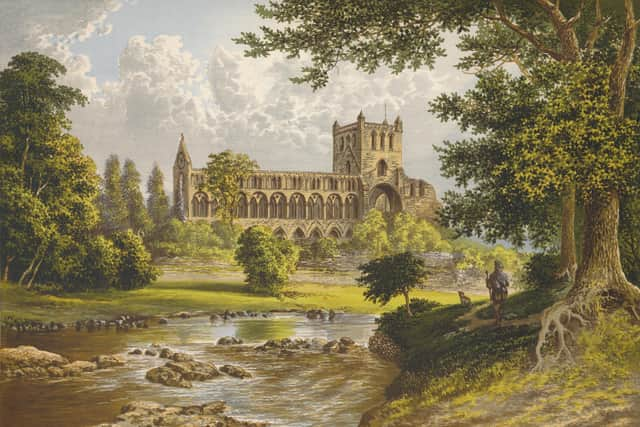After nearly dying out, gourmet pears loved by Mary, Queen of Scots are making a comeback
David I of Scotland found the Borders a tricky area to manage. His solution was to build the four mighty abbeys of Melrose, Kelso, Dryburgh and, in 1138, Jedburgh. The hope was that these religious houses would have a calming effect on the feisty Borderers, and perhaps even their English neighbours. A quick glance at the history of the region tells you that they didn’t. These once-beautiful buildings now lie in ruins, but at least in Jedburgh, the monks left behind their pears.
Scotland had a few hardy varieties of pears before the brothers arrived. Tacitus hints that the Romans brought them to Britain. An army likes to take its booze with it, and if grapes were hard to grow, it makes sense that the resourceful lads of the legion made sure they had something on hand to ferment. They preferred ‘pear wine’ to the apple stuff. One recipe notes the fizzy qualities of the brew. Essentially, Marcus and the boys loved a Babycham.
Advertisement
Hide AdAdvertisement
Hide AdRome held land north of the Border. Perhaps some of their pear trees survived the fall of Empire. The arrival of the Augustinians changed the fortune of the fruit when they were called from France to build the abbey of Jedburgh, and they brought their pears with them. Very popular served after dinner, simmered in honey and wine. One pear, the Warden, was a great favourite. It doesn’t seem to have been a good off-the-tree eater, but baked into a Warden Pie it was a big hit. The monks also used it to make perry. Naturally.


Queens’ trees
They were good orchardmen, the brethren of Jedburgh. Under their care, the trees blossomed. They created even more varieties. They were evacuated and had their roof nicked by Edward I during the Wars of Independence, but their trees thrived. The fame of the Jedburgh pears spread. In the 15th century Mary, Queen of Scots was a fan. She planted a pear tree whilst staying in Jedburgh. They say it lasted for 400 years, until it was blown down in a gale in the 1900s. There’s a replacement tree there today, fittingly donated by Queen Mary in 1934.
The trees survived wars, reformations and King Edward's army. By the 18th century, Jedburgh pears were something of a craze. There are more than 20 varieties to choose from, with slightly magical names. In 1773, Dr John Walker, a man who clearly knew his Conference from his Mother Code, listed Longneville, Auchen, and Bon Chretien, not forgetting the Gray Honey, Swan Egg, and Grey Wife of Glasgow. Dr Walker was impressed. He wrote to his friend, Lord Kames: “There is more fruit about Jedburgh, and more fruit-bearing wood upon the trees, than I have seen in any other part of Scotland."


Pears were exported as far away as the streets of London. The sellers would cry out that ‘Jethart Pears’ had arrived. ‘Jethart’ was a prized mark of quality. Today we’d probably have the same sort of protection around it as Champagne or Wensleydale. In Edinburgh, Mr Sheels could boast in the Caledonian Mercury of 1734 of a delivery of “Bon-Criton Pears, Swan-Egg Pears, Boiling Pears”, available from “the Hand and Orange near to the Cross, Edinburgh; or at his Warehouse in Leith”.
Big prices – and temptation
It was a moneyspinner. In 18th-century London, those pears sold for literally mouthwatering prices. It was well worth planting a tree or two in the garden, a random bit of land, even a gunnel or a wynd. Jedburgh was a boomtown for pear trees, and they were valuable. In 1876, James Tate wrote of pear trees generating £3.00 annually in Georgian Britain. According to the Bank of England inflation calculator, that’s £557.56 today. In 1793, two trees produced 60,000 pears. Money really did grow on these trees.
Anyone who travelled to markets and fairs from Jedburgh tried to take some fruit for trading. The very best eating pears like the White Achan commanded good prices, but there was also the Worry-Carl. Looked good, but more of your crunchy eating. Better slowly baked, really. Mr James Madder of Kelso liked to tell the tale of two Jedburgh lads who went to a Northumberland market with a load of Worry-Carles mixed in with “better sorts” of pears. “The demand was great” and they flogged the lot off as sweet eaters.
Then, in a foolish but slightly predictable move, they adjourned to the pub to take a glass or two to keep out “the Cheviot blaw”. Bad idea, because the next morning they were jumped by angry customers who had been had been “gnashing their teeth in rage over the unmasticable Worry-Carles. Maledictions and Northumbrian curses came volleying out of wayside cottages and smiddy-doors, accompanied with a battery of half-gnawed Worry-Carles, and the derisive shout of “there’s ye’re Jethaght back again”. Let that be a warning. Never short-sell our English cousins when it comes to pears.
Jedburgh pear renaissance
And then, suddenly, the good times were over and the trees began to vanish. At the beginning of the 20th century, big commercial orchards with good transport links began to eat into the pear market. These orchards grew commercially successful varieties, thereby avoiding the wrath of Northumbrians. Names like Conference and Bartlett edged out Drummond and Katherine. Thousands of trees around Jedburgh were felled, and entire varieties were lost.
Advertisement
Hide AdAdvertisement
Hide AdIt should be the end of the story of yet another lost Scottish industry, but things are looking up for the Jedart pear. Specialists are re-discovering and re-creating those old varieties. Local volunteers have been planting and nurturing trees. In season, Jedburgh trees are heavy with fruit again and it’s well worth seeing. Go for the Abbey, by all means, but stay for the pears.
Comments
Want to join the conversation? Please or to comment on this article.

